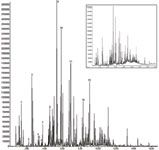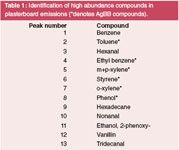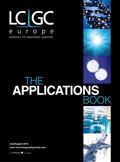Analysing Construction Product Emissions using Novel Micro-Chamber Technology with Thermal Desorption-GC–MS
The Application Notebook
The release of certain chemicals from building products is of increasing concern due to their potentially detrimental effect on human health and the environment; therefore, new regulations requiring the production of low emission materials are currently being implemented. Novel sampling technology has been developed to help building product manufacturers obtain informative emissions data to develop compliant products and maintain product quality on a routine basis.
Caroline Widdowson, Markes International Ltd, Gwaun Elai Medi Science Campus, Llantrisant, UK.
Introduction
Many construction products (e.g., paints, sealants, plasterboard, flooring and wood panelling) are responsible for the release of harmful chemicals, specifically volatile organic compounds (VOCs) and formaldehyde, to indoor air and the environment. Some Chinese plasterboard products, for example, have been found to emit high levels of VOCs, semi-VOCS (SVOCs) and sulphur compounds, which can adversely affect the health of building occupants.1 In response to growing concerns, regulations are being implemented (e.g., the Construction Products Regulation),2 which require the production of low emission, 'green' building materials. Similarly, the German AgBB scheme3 is a product approval standard, which names a variety of VOCs that need to be monitored due to their potential impact on toxicity in consumers.
To develop compliant products and routinely monitor product quality, most manufacturers will want the ability to screen product emissions in-house. Emissions testing for product approval is performed by accredited laboratories and involves incubating materials in an enclosed chamber at (near) ambient temperature under a flow of clean, humidified gas; vapours are exhausted for several days. Emitted vapours are then collected onto a sorbent tube, followed by thermal desorption (TD)-GC–MS for VOC analysis,4 or onto a DNPH cartridge with HPLC for formaldehyde analysis. TD is an automated sample extraction/concentration technique, used to increase the sensitivity of VOC analysis by GC–MS. To simplify and speed up in-house emissions screening for manufacturers, novel micro-chamber technology has been developed. Such equipment is compact, robust and able to process several samples each hour. The emissions data obtained have been shown to correlate with longer term reference tests and can be used to maintain factory production (quality) control and to enhance new product development.5–8 Figure 1 shows a schematic of a micro-chamber for material emissions sampling.

Figure 1: Schematic of a micro-chamber.
A sample of plasterboard was obtained for emissions screening using the micro-chamber–TD-GC–MS system to test the suitability for analysis of a complex sample.
Experimental Conditions
A representative amount of plasterboard (44 mm diameter circle) was placed into one of the chambers of the Micro-Chamber/Thermal Extractor (Markes International Ltd, UK). The chamber was set to 50 °C and a flow of gas (100 mL/min) was applied. A slightly higher than ambient temperature was used to compensate for the relatively small sample size and speed up equilibration (30 minutes) while not significantly affecting the emission profile. The vapour exhausted was collected for 12 minutes onto a 3.5" 6.4 mm OD stainless steel tube (Markes International) packed with quartz wool, Tenax TA (Buchem BV, The Netherlands) and Carbograph 5 TD (Lara Laboratori, Italy).
The tube was then thermally desorbed on a UNITY 2 TD system (Markes International) with subsequent GC–MS analysis (Agilent 6890/5975) under the following conditions:
Tube desorption: 5 min, 300 °C
TD split: 25:1
Focusing trap: Materials emissions trap (Markes International) U-T12ME-2S
Trap low temp: 0 °C
Trap high temp: 300 °C
Column: 30 m × 0.25 mm × 0.5 µm DB-5 phase
Results
The chromatogram obtained was processed using ClearView software (ALMSCO International Ltd, UK) to remove background interference and improve compound identification. The original data file is retained (e.g., for total VOC calculations).
The conditions used during vapour sampling were chosen to provide an emissions profile representative of the plasterboard under normal use. The sorbents and temperatures used for TD were selected to retain the widest possible range of analytes emitted. This method resulted in a complex total ion chromatogram (TIC), comprising a very high number of VOCs and SVOCs, and a wide range of analyte concentrations, illustrating the versatility and efficiency of the combined analytical system (Figure 2).

Figure 2: Drywall emission profile post-ClearView (original profile is shown inset).
Table 1 lists some of the most significant volatile and semi-volatile compounds in the TIC. Benzene, a known carcinogen, along with phenol and toluene, which affect the central nervous system and kidneys, were detected. In addition, with the new building product regulations in mind, several compounds of particular interest were found in the plasterboard emission profile; a number of VOCs specified by the AgBB scheme which were detected are highlighted with an asterisk in Table 1.

Table 1
Screening data can be used by manufacturers to confirm product conformity, and develop new low-emission, higher-value products. It can also be useful for pre-screening samples going for third party tests and for evaluating emission profile variations across a product range.
Conclusions
Recent innovations in micro-chamber technology allow manufacturers to screen emissions for their products in-house. The generation of a comprehensive chemical profile, as shown here, has resulted in the detection of a wide range of VOCs and SVOCs emitted by the sample. In addition, several compounds targeted under key construction product test protocols were identified. This demonstrates that the micro-chamber–TD-GC–MS methodology can be used to obtain useful emissions data from chemically complex building products. Such data will enable a company to routinely test their products to comply with regulations and to develop new low emission materials, thus protecting their business, the consumer and the environment.
References
1. L.E. Saltzmann, US Consumer Product Safety Commission staff summary of contractor's indoor air quality assessment of homes containing Chinese drywall (2009).
2. EC Construction Product Regulation (CPR) http://ec.europa.eu/enterprise/sectors/construction/construction-products/index_en.htm
3. AgBB Scheme: Health-related evaluation of emissions of volatile organic compounds (VOC and SVOC) from building products (2010).
4. Markes International TDTS Note 89: Thermal desorption technology for testing chemical emissions from construction products and consumer goods (2010)
5. T. Schripp et al., Analytical and Bioanalytical Chemistry, 387(5), 1907–1919 (2007).
6. PARD report: G.J. Williams and M. Pharaoh, Correlation between the VDA 276 test and micro-chamber testing. Issued by WMG, University of Warwick, UK (2009).
7. Markes International TDTS Note 67: Introducing the Micro-Chamber/Thermal Extractor (µ-CTE) for rapid screening of chemicals released (emitted) by products and materials (2010).
8. Markes International TDTS Note 68: Using Markes emission screening technology to simplify compliance with the latest construction product regulations (2010).

Markes International Ltd
Gwaun Elai Medi Science Campus, Llantrisant CF72 8XL, UK
tel. +44 1443 230935 fax +44 1443 231531
Website: www.markes.com

The Benefits of Custom Bonded Silica
April 1st 2025Not all chromatography resins are created equal. Off-the-shelf chromatography resins might not always meet the rigorous purification requirements of biopharmaceutical manufacturing. Custom bonded silica from Grace can address a wide range of separation challenges, leading to real performance improvements. Discover more about the latest innovations in chromatography silica from Grace, including VYDAC® and DAVISIL®.
5 Things to Consider When Selecting a Chromatography Silica
April 1st 2025Particularly in the pharmaceutical industry, drug purity isn’t just a goal – it’s essential for achieving safety, stability and efficacy. However, purification is easier said than done, especially with challenging molecules like DNA and RNA “oligonucleotides,” due in large part to their diversity and the range of impurities that can be generated during production. Enter DAVISIL® chromatographic silica, with a wide range of pore diameters and particle sizes to meet your specific application, performance and sustainability requirements. Before you choose the chromatography resin for your next purification application, take a look at these 5 considerations.
Automating Protein Purification: Efficiency, Yield, and Reproducibility
March 27th 2025Recent advancements in automated protein purification stress the importance of efficiency, scalability, and yield consistency. This eBook compares different purification platforms, highlighting their impact on downstream applications and demonstrating how automation enhances throughput and process control.
MilliporeSigma: Ultrapure Water for Sensitive LC-MS Analysis of Pesticides
March 25th 2025The aim of the study was to illustrate the efficiency of Milli-Q® water purification systems in eliminating pesticides from tap water, thereby producing and delivering reliable and consistent-quality ultrapure water suitable for pesticides analysis














